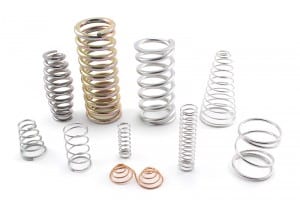 Compression spring end types vary relative to their application. Though the end type distinctions are minor, they one of the defining features of a compression spring and are, therefore, important to the functionality of the device. There are basically two end designs, open and closed, with another two variations making a total of four end types. The variations affect the spring’s pitch, its solid height when loaded, its number of active and total coils, the free length of the spring when unloaded, and its seating characteristics in a device.
Compression spring end types vary relative to their application. Though the end type distinctions are minor, they one of the defining features of a compression spring and are, therefore, important to the functionality of the device. There are basically two end designs, open and closed, with another two variations making a total of four end types. The variations affect the spring’s pitch, its solid height when loaded, its number of active and total coils, the free length of the spring when unloaded, and its seating characteristics in a device.
Compression Spring Design
The design of the end types of compression springs should not be confused with the variety of configurations, shapes, and sizes that compression springs are manufactured in. Perhaps the most common type of spring, the familiar coil is designed to carry a load, as the name suggests, when compressed. It provides resistance and absorbs force, creating the necessary energy to carry the load. Compression springs are used as shock absorbers, vibration-dampers, as pure energy accumulators and as force generators. Their shapes may differ, too. Most common are the straight compression spring with tapered ends; the conical, in which the radius decreases at the end; the hourglass, convex shape that tapers at the center; and the barrel-shaped concave spring, which is wide at the center.
Like configuration or shape, the end type characteristics of compression springs vary. They may have open ends; open with ground ends; closed with non-ground ends, and closed ends that are squared and ground. In open-ended types, the spring has a constant and consistent pitch for each coil, with no pitch change through the end of the spring. In the open, ground-ended compression spring, the coils at either end are less parallel, achieved through an end grinding operation that leaves it flat in appearance. In closed-ended, but not ground compressions springs, the pitch of the coils at either end is reduced to allow the end coils to touch. The closed-ended, ground square compression springs are similar to a closed-end design, but the ends here are ground to a flat plane.
Design requirements of the application determine which compression spring end type to use. Generally, open-ended springs are used in special applications. Whether open and ground or open and not ground, the springs cannot support themselves. They are designed to fit over a rod, shaft or another form of support necessary to hold the spring upright. Usually, open-ended designs are for smaller springs and as a cost-saving measure for large commercial production runs.
Squaring & Closing
Squaring and closing the ends of a spring allows them to sit flat. It is a secondary operation that requires grinding. Though adding to the cost of production, the application may require the spring to sit flat to prevent or reduce buckling. But it also makes the free length and spring rate more precise. These end types of compression springs, closed and ground, are more expensive but are also the most common. They are typically larger and designed for precision applications. Like open-ended springs, closed and not ground spring end types are used for smaller springs and large production runs.
A spring’s end type also affects how its axial force can be transferred to adjacent parts in a mechanism. Where open ends are suitable in some applications, a squared, closed-ended design offers a reduced chance of tangling in other applications. The end types of the spring and how parallel they are to each other also factors into its design. Deflection range, uniform configuration and closing tension are all affected by the end coils.
Benefits
Though the designs of compression springs come in several variations suited for different types of applications, they still provide the same benefits. No matter the end type, compression springs have the ability to resist the movement of another component within the device. They also return the component to its preload or desired position. Compression springs provide the consistent pressure needed to operate devices, too.
It’s been said that there may be no other mechanical device more indispensable than the spring, with the compression spring the most widely used type. Selecting the right spring end type relates to the design requirements for the application. A compression spring’s elastic coil is versatile and efficient, and the force produced by it makes them an excellent component for storing energy. Whether with an open or closed-end, compression springs are found in everyday items, such as vehicles, pens, and mobile phones, which make them among the leading components in applications of all sizes, in all industries, with millions of unique uses worldwide.

